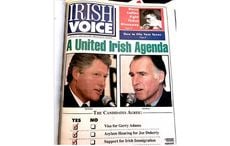THE great waves of immigration from Ireland to America were just beginning when in May of 1836 a group of Irish Catholic men in New York and Pennsylvania formed a benevolent society called the Hibernians to help newly arrived immigrants.
The Ancient Order of Hibernians (AOH), as they became known, were linked to a group called the Defenders in Ireland, which fought oppressive British landlords and provided protection to priests. A Mass at the Basilica of Old St. Patrick’s in New York last weekend marked the 175th anniversary of the AOH, the longest tenure of any such ethnic or fraternal organization in the U. S.
New Yorkers know well the Hibernians for their proud, full presence and long association with the St. Patrick’s Day parade. Each St. Patrick’s Day New York’s archbishops remind Mass-goers of the Hibernians’ response in 1854 to the pleas of then Archbishop John Hughes to defend the original St. Patrick’s Church at Prince and Mulberry Streets against threats by Nativist bigots to burn it. The Hibernian headquarters was nearby.
The Know-Nothings, as they were called, had succeeded in burning an Ursuline Convent in Massachusetts and St. Augustine’s Church in Philadelphia, but they failed to destroy the cathedral, now designated a basilica by Pope Benedict XVI.
Despite the anti-Catholic bigotry and anti-Irish sentiment prevalent in America in the late 19th and early 20th century, the Hibernians grew.
At its peak in 1916 the AOH was led by Pennsylvania Congressman McLaughlin and boasted 250,000 members from Portland, Maine to Yreka, California.
Century old Hibernian Halls still stand in Bristol, Pennsylvania, Butte, Montana and Turners Falls, Massachusetts.
An example of the AOH’s many gifts to churches can be found in two stained glass windows in St. Raphael’s Catholic Church in Long Island City.
Today the AOH is still assisting Irish immigrants, promoting immigration reform and advocating for the peaceful re-unification of Ireland.
It remains a strong voice for truth about the persecution and killings of the Catholic minority in Northern Ireland and for justice for the many victims of the conflict.
The national president of the AOH, Seamus Boyle of Philadelphia, recently appealed to President Obama to demand greater cooperation from the British in the search for truth on the unsolved murders of nearly 1,000 Catholics.
The record of the AOH in America is unique not only for its long tenure, but for its singular efforts to commemorate in art, word and deed the contributions and sacrifices of Irish and Irish Americans to the growth and defense of the country, to the welfare of the Catholic church and to Ireland’s peace and prosperity.
That is a legacy for which all Americans can be proud.
Michael J. Cummings
Former National Archivist, AOH
Albany, New York




Comments